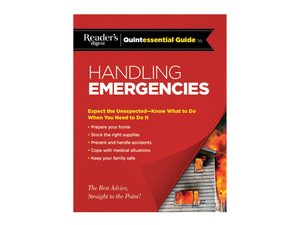First Aid for a Sprained Ankle: 6 Steps to Take Immediately
Updated: Aug. 10, 2017
A sprained ankle is the most common ankle injury. Here's what to do to treat a sprained ankle to minimize pain and speed recovery.
A sprain occurs when one or more of the ligaments has been stretched, twisted, or torn. It is the most common ankle injury. In a minor sprain, some of the fibers within the ligament are stretched. In more serious sprains, the ligament may be torn. Minor sprains can be treated at home. Serious sprains need medical attention and may even require surgery. The pain can be excruciating. If in doubt, take the injured person to the hospital for an X-ray.
[pullquote]Use RICE to remember treatment steps.
R = Rest. I = Ice. C = Compression. E = Elevation.[/pullquote]
What to Look For
- With a severe injury, the patient may not be able to bear weight on the leg.
- Pain in and around the joint. The patient may feel faint with the pain.
- Swelling, and later bruising, around the joint
First Aid for a Sprained Ankle
1. Rest the leg. The patient should stop the activity that caused the injury. Help her to sit down and rest the ankle. Support it in a raised position.
2. Cool with ice. Cool the ankle to reduce pain and swelling. Ideally wrap a bag of ice or frozen peas in a cloth and place it on the ankle. Do not put ice straight onto the skin, as it will cause a cold burn. Leave the ice in place for about 20 minutes.
3. Apply pressure. Leave the compress in place if it is small or wrap a layer of soft padding, such as a roll of cotton wool, around the ankle. Apply pressure with a compression support or compression bandage to help limit swelling. This should extend from the toes to the knee.
4. Elevate the ankle. Raise and support the ankle so that it is higher than the hip to prevent swelling. Advise the patient to rest the ankle. If you suspect serious injury, take the patient to the hospital.
5. Check circulation. Make sure that the bandage is not too tight. Press on a toenail until it turns white, then let go. The color should return quickly. If it does not return, the bandage is too tight; remove it and reapply. Recheck every 10 minutes.
6. Reapply the cold compress over the bandage every two to three hours. Remove the bandage at night and do not sleep with an ice pack on the injury.
 Get more information about handling health emergencies and natural disasters in the new book Reader’s Digest Quintessential Guide to Handling Emergencies. You’ll get must-know tips and tactics for preparing your home, stocking the right supplies, preventing and handling accidents, coping with medical situations, and keeping your family safe. Learn more and buy the book here.
Get more information about handling health emergencies and natural disasters in the new book Reader’s Digest Quintessential Guide to Handling Emergencies. You’ll get must-know tips and tactics for preparing your home, stocking the right supplies, preventing and handling accidents, coping with medical situations, and keeping your family safe. Learn more and buy the book here.




